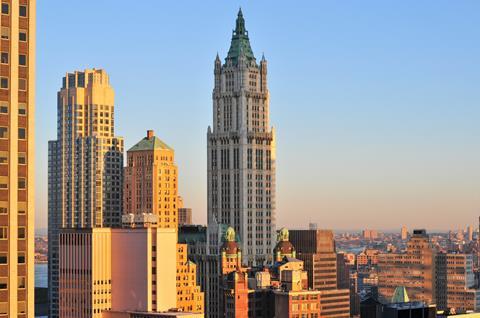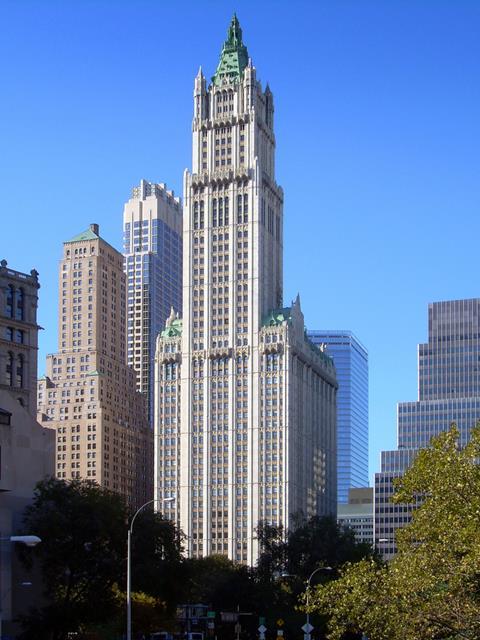How Building charted the rise of the Big Apple’s tallest pre-First World War skyscraper

The word “skyscraper” was first used in the 1880s to describe a series of tall buildings in Chicago made possible by advances in steel frame construction. Although none of them were more than 20 storeys high, city authorities deemed them unsightly and quickly set height limits for new buildings.

It was not until the first decade of the 20th century that skyscrapers really took off in the United States, this time in New York. The template was set by the 21-storey Flatiron Building, which was an instant hit with New Yorkers when completed in 1903. The next leap was the now-demolished 41-storey Singer Building, opened in 1908, followed a year later by the 50-storey Metropolitan Life Insurance Company Tower.
The culmination of New York’s first tower boom was the 55-storey Woolworth Building, opened in 1913. Its gothic profile and internal features, including the world’s fastest lifts and a swimming pool, made it an international icon of modernity.
An economic downturn soon after it was completed and the introduction of new zoning restrictions ensured that it held its title of the world’s tallest building until 1930, when it was finally taken over by the Chrysler Building.
News item, 26 May 1911
Woolworth Building, New York City.
New York’s latest and greatest skyscraper, now in course of construction for Mr. F. W. Woolworth, is notable for other qualities than its enormous size. It will add a new and dominating feature to the picturesque skyline of the American metropolis. It is remarkably well-planned; and as vigorous, clean, and decorative architecture, is probably unequalled by any other commercial building in the same style. Such a gigantic structure cannot be satisfactorily shown by the means to which we are limited, as no drawing can at once show the design and the effect the design produces upon the beholder of the actual building.
…
The Woolworth building is now under construction, and is located on the west side of Broadway occupying the block front from Barclay-street to Park-place. It is opposite the United States Post-office and diagonally across Broadway from the New York City Hall.

The building has a frontage on Broadway of 152 ft. 1 in.; on Park-place of 197 ft. 10 in.; and on Barclay-street of 192 ft. 6 in. The property is owned by the Broadway Park-place Company, F. W. Woolworth, President. This Company has acquired the property facing Park- place next west of the building, so as to assure its light in the rear.
The principal feature of the building is a great tower 86 ft. by 84 ft. square, rising to a total height of 750 ft. above the sidewalk. This makes a structure fifty-five stories high, including all stages up to the great electric light, which is proposed to be placed at the apex of the tower. The main building is to be twenty-nine stories high, with two stories in the gables on the north and south front, making thirty-one stories at the highest point of the main structure. The ground story or street floor is designed for stores and an arcade with openings on Broadway, Park-place, and Barclay-street. This arcade will contain a large number of attractive shops being with fronts entirely plate-glass, or available for open fronts as may be later determined.
The banking floor or mezzanine story on the Park-place side will be occupied by the Irving National Bank, and indeed the project originated with the demand of this bank, and a first- class Broadway location.
The basement will contain a safety deposit of ample dimensions, and giving first-class facili- ties. There will be a restaurant and rathskeller in the basement, a barber shop, and a number of storage rooms which can be connected directly with the stores above, and some of which may be available for other tenants. In connexion with the barber shop it is proposed to put in a large swimming tank.
The machinery, coal storage, refrigerating plant, power plant, electric generators, filtration plant, and other mechanical equipment, will be placed in the sub-basement. A club will be located in the twenty-eighth story. The balance of the building will be used for office purposes. There will be a look-out gallery at the fifty- fourth floor accessible for visitors.
The exterior of the building will be of stone and terracotta, and may be classed as Gothic in style, although it is a type of Gothic developed to meet the special needs of the modern American high office building. The necessity of frequent and regularly recurring window openings and the fixed locations of the steel columns and girders necessarily established certain conditions of design which are not to be found in Gothic buildings of the Old World, and require a development suited to modern needs.
Provision has been made for thirty-four elevators, of which twenty-four are grouped nearer the Broadway entrance in four banks of six each. At the west end of the building there are two large freight elevators available for passenger service. Provision has been made for additional minor elevators for the bank, stores, observation gallery, etc.
The total cubical contents of this building measured from the top of the caissons exceeds 13,200,000 cubic feet. The caissons extend down to rock, and are bedded upon the solid rock from 110 ft. to 130 ft. below the level of the sidewalk. These caissons are of enormous dimensions, some of them being as great as 19 ft. in diameter. This is one of the largest caissons contracts ever executed. It was deemed imperative for so great a building as this that the foundation should be absolutely secure and above any possible question, so a very considerable portion of the cost of the building goes into the foundation.
The construction of the building, of course, is absolutely fireproof throughout, and every provision has been made for the greatest comfort and safety of all occupants. Four self-contained stairways are provided from the roof to the level of the street. Duplicate self- contained stairways are provided in the tower, in addition to which there is an outside fireproof staircase in the court accessible from the corridors of each wing. These self-contained stairs are entirely separated from the corridors and office spaces by fireproof walls and by wire glass doors. This would make the stairways smokeproof as well as fireproof, so that in the remote chance of a local fire in any part of the building causing smoke, the stairways would be entirely free from it. The elevators are likewise self-contained, being separated from the corridors by iron and wire glass doors. In short, every precaution has been taken to render the building absolutely fireproof and of the highest class of construction in every respect.
The contract for the foundation work was let last November to the Foundation Company of New York, and the work has been under way since that time, and is now largely completed.
The general contract for construction was recently awarded to the Thompson-Starrett Company of New York, who are the contractors for the new municipal building and many other large structures in this city and elsewhere in the United States.
The sub-contract for structural steel, amounting to over 20,000 tons of metal, has already been awarded. The consulting engineer for the structural work is Mr. Gunvald Aus, of New York.
Drawings for the general construction of the building were filed with the Department of Building, April 24. The work is now being rapidly organised, and it is intended that the building shall be completed in the autumn of 1912.
News item, 13 September 1912
STEEL FRAME OF THE WOOLWORTH BUILDING
THE main portion of the Woolworth Building, now under construction in New York, encloses three sides of a light court measuring 95 ft. by 37 ft. in plan, and will be about 400 ft. high from street level to the main roof, above which the tower will rise to a further height of 400 ft.
For the support of the sixty main columns destined to receive the weight of the entire building foundation piers of concrete have been carried 40 ft. down to solid rock.

Upon the piers are steel grillages and distributing girders and cantilevers. The grillages consist of heavy I-beams laid in two or more tiers, according to the load to be carried, and embedded for protection in 1:2:4 Portland cement concrete. The distributing girders extending from pier to pier were laid in trenches before the general excavation was carried down to the same level.
To furnish some idea as to the duty of these members we may say that one of them, designed for supporting one of the tower columns, representing a load of 4,250 tons, measures 5 ft. 9 in. wide by 8 ft. deep by 23 ft. long, and weighs 58 tons.
Seven girders of the same dimensions and weight are included in the foundations, the other distributing girders weighing from 22 tons to 27 tons each.
Steel for the superstructure was sent from the works of the American Bridge Company to the goods depôt of the Pennsylvania Railroad at Greenville, New Jersey, where it was sorted and dispatched to New York in lighters as required, being transported through the streets on special lorries.
The largest column section delivered on the site measures 30 ft. long and weighs 40 tons. The average weights of the columns are as follows:- First tier, 40 tons; second tier, 33 tons; third tier, 31 tons; eighth tier, 15 tons; fourteenth tier, 12 tons; main roof, 10 tons. On August 11, 1911, the first grillage beams were delivered, and on September 15, 1911, the first foundation girders were received, the first columns arriving ten days later, and the first consignment of steel for the superstructure coming to hand on October 20, 1911.
On the last-mentioned date the first columns were erected, and by the end of November the steel frame had been constructed up to street level.
By April 6, 1912, the frame had been carried up to the height of the main roof, the structure to that level including thirty stories and about 17,000 tons of steel.
The work of erection was performed by four derrick gangs of eight men each, who were able to complete two tiers per week, and whose record was 1,153 tons of steel erected in six consecutive days of eight hours each.
It is interesting to record the fact that although the contract conditions required the whole of the steel to be erected by July 15 last, this part of the work was practically finished by the end of June.
The construction plant provided for erecting the superstructure included four steel guy derricks, with the lifting capacity of 30 tons, and one timber guy derrick of 15 tons capacity.
These derricks commanded the entire site and the adjacent street. Consequently they could be employed for unloading lorries and delivering the steel to required positions in any part of the building.
The large amount of riveting necessary in the steel frame was performed by twenty-two gangs of four men each, by whom about 300 rivets were inserted per day of eight hours, with the aid of pneumatic riveting hammers. The riveters were followed by a gang of thirty-five painters, who applied two coats of paint to all the steelwork.
Comment, 7 November 1913
The Limit of the Skyscraper
The announcement that a limit will probably be placed on the height of the buildings of New York suggests that one of the most interesting phases of modern building has reached a certain stage in its development which may possibly prove to be final. Although there is said to be no structural objection to building skyscrapers of twice the height of the present ones, the fact that forty-one out of forty-three building experts of New York considered a limitation of height to be desirable suggests there is no practical utility in so doing. So wonderful has been the advance of modern building construction in recent years that we naturally hesitate to place any definite limits to its capabilities in this direction, yet it is evident that there must be a limit somewhere.
The question is are the advantages of high buildings so great as to justify New York in proceeding to find out this limit by practical experiment? The Report of the Height of Buildings Commission suggests that they are not, and the Fire Department of New York seems to be of the same opinion. In the interests of scientific - or should we say artistic? - experiment we regret this conclusion. Not that we are altogether enamoured of skyscrapers, but history seems to assure us that all the great architectural achievements of the past have been obtained by carrying a definite system of construction to as logical a conclusion as the strength of materials and other practical limitations would permit. Indeed it has seriously been maintained that all progress in architecture has been due to the love of experiment in building, to the constructor’s passion for the creation of more and more daring and exquisitely-balanced structures as witness the Pantheon, St. Sophia, or Beauvais. In these latter days we have steel, reinforced concrete, and the skyscraper. The lover, of experiment will think it a pity that this new method also cannot be carried to its logical conclusion, but must be limited by considerations other than the qualities of its materials or the nerve and skill of the constructors.
We are bound to admit, however, that our passion for experiment is limited, too. The first results of experiment are apt to be crude, and skyscrapers were no exception to the rule. A crudity 600 ft. high asserts itself somewhat; is just one of those things there is no getting away from. We are all for the advancement of knowledge, but we cannot bring ourselves to contemplate London dotted over with such experiments. We would rather they were carried on elsewhere, and can contemplate them in New York with the most perfect equanimity. Distance and the intervening ocean may account for this. On the whole, we would rather leave them to the Americans, and they could not be left in the hands of more daring and competent constructors.
>> Nelson’s Column runs out of money, 1843-44
>> The clearance of London’s worst slum, 1843-46
>> The construction of the Palace of Westminster, 1847
>> Benjamin Disraeli’s proposal to hang architects, 1847
>> The Crystal Palace’s leaking roof, 1851
>> Cleaning up the Great Stink, 1858
>> Setbacks on the world’s first underground railway, 1860
>> The opening of Clifton Suspension Bridge, 1864
>> Replacing Old Smithfield Market, 1864-68
>> Alternative designs for Manchester Town Hall, 1868
>> The construction of the Forth Bridge, 1873-90
>> The demolition of Northumberland House, 1874
>> Dodging falling bricks at the Natural History Museum construction site, 1876
>> An alternative proposal for Tower Bridge, 1878
>> The Tay Bridge disaster, 1879
>> Building in Bombay, 1879 - 1892
>> Cologne Cathedral’s topping out ceremony, 1880
>> Britain’s dim view of the Eiffel Tower, 1886-89
>> First proposals for the Glasgow Subway, 1887
>> The construction of Westminster Cathedral, 1895 - 1902
>> Westminster’s unbuilt gothic skyscraper 1904
>> The great San Francisco earthquake, 1906
>> The First World War breaks out, 1914
>> The Great War drags on, 1915 - 1916



























No comments yet